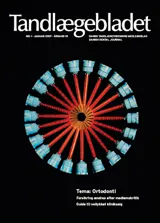Ansigtstraumer modtaget via Rigshospitalets traumecenter 2000-2004
Frakturer i ansigtsskelettet optræder enten som solitære skader eller som en del af et multitraume. Modtagelsen af multitraumatiserede patienter varetages i dag i traumecentre landet over. I Hovedstadens Sygehusvæsen (H:S) blev Rigshospitalets TraumeCenter etableret i 1999, og traumecentret modtager efter forud fastlagte mekaniske, anatomiske og/eller fysiologiske kriterier primært visiterede traumepatienter fra H:S, samt sekundært visiterede traumepatienter fra det øvrige Østdanmark, Bornholm, Færøerne og Grønland. Rigshospitalets HovedOrtoCenter har ansvaret for det fortsatte behandlingsforløb i centrets egne klinikker. Patienter med kæbefrakturer visiteres til videre behandling i Kæbekirurgisk Klinik. Her bringes en opgørelse over 284 patienter visiteret fra TraumeCentret til videre behandling i Kæbekirurgisk Klinik i perioden 01.01.2000-31.12.2004.
Facial fractures received by the Trauma-Centre, University Hospital, Copenhagen, 2000-2004: Fractures in the facial skeleton occur either as solitary injuries or as a part of multiple trauma. The management of multi-traumatized patients takes place in Trauma-Centres throughout Denmark. In the capital area the Trauma-Centre of the University Hospital of Copenhagen was established in 1999. Patients with facial fractures are referred to continued treatment at the Department of Oral and Maxillofacial Surgery. This article brings an overview of the development of the cooperation between the Trauma-Center and the Department of Oral and Maxillofacial Surgery during the first four years of the centre’s existence. We studied the medical charts of 284 patients referred from the Trauma- Centre to further treatment at the Department of Oral and Maxillofacial Surgery and looked at causes of injury and fracture type and location. Our findings are similar to previous studies, although a variation due to cultural, demographic and social factors exists. This emphasizes the need for preventive measures and public campaigns. We conclude that the severity and complexity of facial trauma require interdisciplinary treatment and place the speciality of oral and maxillofacial surgery as an integral part of the interdisciplinary trauma team.


